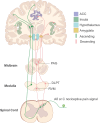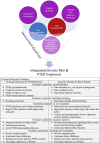The pain of PTSD: integrating persistent or chronic pain within emotional processing theory of posttraumatic stress disorder
- PMID: 40168176
- PMCID: PMC11963193
- DOI: 10.1080/20008066.2025.2479923
The pain of PTSD: integrating persistent or chronic pain within emotional processing theory of posttraumatic stress disorder
Abstract
Background: Posttraumatic stress disorder (PTSD) and chronic pain are devastating conditions that often co-occur. Current understanding of comorbid PTSD and chronic pain is limited, and treatment options are undereffective.Objective: This paper presents a theoretical basis for conceptualising chronic pain symptoms within Emotional Processing Theory (EPT), the foundation for Prolonged Exposure (PE), an effective treatment for PTSD. EPT conceptualises the development and treatment of PTSD using a trauma structure that strongly overlaps with pain's neurobiology.Method: This paper proposes a model of shared aetiology and treatment of comorbid PTSD and chronic pain, emphasising these shared neurobiological underpinnings. Discussion details how the comorbidity is maintained through parallel avoidance processes focused on: (1) trauma memories and reminders in PTSD preventing reduction of negative affect (extinction) and inhibitory learning, and (2) physical pain in chronic pain fuelling increased pain and reduced function.Results: A conceptualisation is presented on how PTSD and chronic pain symptomology can be addressed within the EPT framework, increasing the confidence of providers and patients while addressing an important gap in the literature. Finally, recommendations for providers using PE with patients with PTSD and pain are provided including a case example and treatment plan based on real patients.Conclusions: This model provides a clinically useful understanding of the underlying neurobiology for the co-occurrence of PTSD and chronic pain and offers direction for future research.
Antecedentes: El trastorno de estrés postraumático (TEPT) y el dolor crónico son condiciones devastadoras que frecuentemente ocurren juntas. El entendimiento actual de la comorbilidad del TEPT y el dolor crónico es limitado, y las opciones de tratamiento no son efectivas.
Objetivo: Este artículo presenta una base teórica para la conceptualización de los síntomas de dolor crónico dentro de la Teoría del Procesamiento Emocional (TPE), la fundación para la Exposición Prolongada (EP), un tratamiento efectivo para el tratamiento del TEPT. TPE conceptualiza el desarrollo y tratamiento del TEPT usando una estructura del trauma que se superpone fuertemente con la neurobiología del dolor.
Método: Este artículo propone un modelo de etiología compartida y de tratamiento de TEPT y dolor crónico comórbidos, enfatizando que estos comparten fundamentos neurobiológicos. La discusión detalla cómo la comorbilidad es mantenida a través de procesos de evitación paralelos centrados en: (1) las memorias de trauma y los recordatorios en el TEPT previniendo la reducción del afecto negativo (extinción) y el aprendizaje inhibitorio, y (2) el dolor físico en el dolor crónico alimentando el aumento del dolor y una reducida función.
Resultados: Se presenta una conceptualización en cómo la sintomatología del TEPT y el dolor crónico puede ser abordado dentro del marco de la TPE, aumentando la confianza de los proveedores y los pacientes, mientras se aborda una brecha importante en la literatura. Finalmente, las recomendaciones para los proveedores en usar EP con los pacientes con TEPT y dolor será discutida incluyendo el ejemplo de un caso y plan de tratamiento basado en pacientes reales.
Conclusiones: Este modelo proporciona un entendimiento clínico útil de la neurobiología a la base de la co-ocurrencia del TEPT y el dolor crónico y ofrece direcciones para investigaciones futuras.
Keywords: PTSD; TEPT; case vignette; chronic pain; comorbidity; comorbilidad; dolor crónico; emotional processing theory; neurobiology; neurobiología; teoría de procesamiento emocional; tratamiento; treatment.
Plain language summary
PTSD and chronic pain are highly comorbid may have shared neurological processes.Integrating chronic pain development and treatment within the emotional processing theory framework can support integrated treatment and increase access to care for those with PTSD and chronic pain.An integrated model for treatment of PTSD and chronic pain using emotional processing theory to conceptualise the interplay of distress is presented.
Conflict of interest statement
No potential conflict of interest was reported by the authors.
Figures






References
-
- American Psychiatric Association . (2013). Diagnostic and statistical manual of mental disorders (DSM-5®). American Psychiatric Association.
-
- Åkerblom, S., Perrin, S., Fischer, M. R., & McCracken, L. M. (2022). Prolonged exposure for pain and comorbid PTSD: A single-case experimental study of a treatment supplement to multiprofessional pain rehabilitation. Scandinavian Journal of Pain, 22(2), 305–316. 10.1515/sjpain-2021-0100 - DOI - PubMed
-
- Barlow, D. H. (2004). Anxiety and its disorders: The nature and treatment of anxiety and panic. Guilford Press.
MeSH terms
Grants and funding
LinkOut - more resources
Full Text Sources
Medical
Miscellaneous
